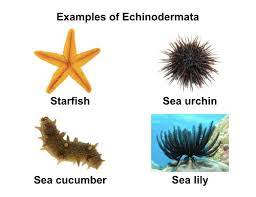Phylum Echinodermata
Invertebrates with spiny skin are known as echinoderms. The endoskeleton of these creatures is made up of calcareous ossicles. All of them are marine, having organ-system organization. There are no freshwater or terrestrial organisms in this phylum. Adult echinoderms have radial symmetry, whereas larvae have bilateral symmetry. They are coelomate and triploblastic creatures. With the mouth on the bottom (ventral) side and the anus on the upper (dorsal) side, the digestive system is complete. Echinoderms are distinguished by the presence of a water vascular system that aids motility, food capture and transport, and breathing. This system has a central ring canal and radial canals that extend along each arm. Through these structures, water circulates. The madreporite is a structure present on top of the body. This is responsible for the regulation of the water in the water vascular system. There is no excretory system. Sexes are distinct. Reproduce sexually. External fertilization is common. The development of free-swimming larva is indirect. Asterias (starfish), Echinus (sea urchin), Antedon (sea lily), Cucumaria (sea cucumber), and Ophiura (Brittle star) are among examples.


 ACME SMART PUBLICATION
ACME SMART PUBLICATION
